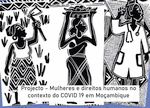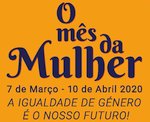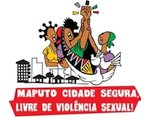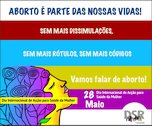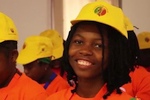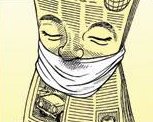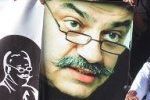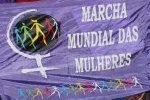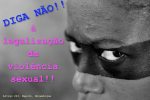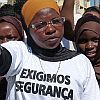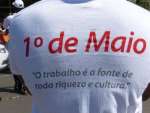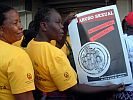Trafficking of Women & the 2010 World Cup: the risk of an increase in sexual exploitation connected to trafficking
WLSA Mozambique
Introduction
The World Cup is a male football competition that is organised once every four years by the International Federation of Association Football (commonly known by its French acronym, FIFA). The cup is the second biggest sports even in the world after the Summer Olympic Games, and the next one will take place in South Africa, in June and July of 2010. The last cup was held in Germany in 2006.
During the cup, it is expected that South Africa will become the centre of the world, and half a million people will converge there, among players, spectators, tourists and investors in search of business. The South African people, in particular, hope for an improvement in their own economic situation, as an estimated 129,000 jobs might be created during this period1.
However, the celebration of the king of sports, football, hides another phenomenon: the trafficking of women and girls for prostitution. Like in previous World Cups, the organised networks that specialize in the trafficking of women and children are preparing to supply the brothels because of the increase in demand for this type of service in big events like these.
During the 2006 World Cup, held in Germany, an estimated 40,000 women might have been imported from Central and Eastern Europe to supply a gigantic complex linked to prostitution, built right next to the main cup stadium in Berlin and able to receive at least 650 male clients simultaneously. Many “sex huts”, also known as “delivery cabins”, were also built, with condoms and showers, for those wishing to remain anonymous. The Coalition Against Trafficking in Women to Europe (CATW) launched an international petition against organised prostitution, denouncing the existence and intensity of trafficking in sports events, associated with the legalisation of prostitution in the host countries2.
I. Some characteristics of the trafficking
Awareness about the trafficking of women has been rising in recent years, thanks to the pressure of human rights movements, especially feminist ones. This has attracted the attention of countries and United Nations agencies. Profits from trafficking are supposed to be growing, making this business an extremely profitable proposition.
The need to prevent and eradicate people trafficking forced the definition of the phenomenon. In “The United Nations Protocol to Prevent, Suppress and Punish Trafficking in Persons” of 2000 it is defined as: “The recruitment, transportation, transfer, harbouring or receipt of persons, by means of the threat or use of force or other forms of coercion, of abduction, of fraud, of deception, of abuse of power or of a position of vulnerability or of the giving or receiving of payments or benefits to achieve the consent of a person having control over another person, for the purpose of exploitation.” (U.N. 2001, cited by Choi-Fitzpatrick, 2006).
Still according to the same Protocol, “child” means anyone younger than 18 years old.
The following aspects stand out in this definition:
- The forced or deceptive nature of the recruitment (deception also referring to coercion);
- The abuse of power and the control of another person with the objective of exploiting her.
Although it does not mention explicitly that most victims of trafficking are women and girls, the definition is sufficiently broad to include the forms of coercion that are specific to women, because they are a product of patriarchal systems and contribute to their vulnerability to this form of exploitation. Specifically, by including the “position of vulnerability” of some of the victims, it questions the “consent” argument, recognising that many women and girls victims of trafficking are forced to accept these forms of exploitation by people that hold some form of authority over them, such as husbands, parents and relatives in general.
As stated by the Co-Executive Director of the “Coalition Against Trafficking in Women” (Leidholdt, 2004), it was not a peaceful process as there were several interests in contention:
- On the one hand, the interests of the sex and pornography industry who want to legalise prostitution in as many countries as possible in order to expand their activities. Therefore, the aim of its lobbying activity, some of it from organisations that pretend to defend human rights, is to avoid the recognition of sexual exploitation as the main objective of the trafficking of women.
- On the other hand, together with other interest groups it attempts to replace the concept of “trafficking of women” with “human trafficking” to hide the gender basis of this phenomenon and portray it as a problem that affects both men and women. In reality, women are not only more vulnerable because of the socio-cultural contexts in which they live, but are also more exploited, serving as labour force as well as being sexually exploited.
Leidholdt (2004) interprets trafficking in a broader sense, including all activities of buying and selling bodies of women and children, and contemplating the micro-level – in the family – and the macro-level – international traffic. Commenting on the agenda of a 2003 conference on the subject, she stated: “You would never know that trafficking has anything to do with gender, sex or women”.
This situation warns us to the need to carefully analyse the relationship between prostitution and trafficking. The studies consulted (GTZ, 2003; Rossi et al., 2003; Truong, 2006; WLSA Regional, 2005) show that the trafficking of human beings aims for their exploitation for sexual or work purposes, and has an international dimension. The main victims of trafficking are women and children of both sexes that are taken to another country where they remain as legal or illegal immigrants. The place of destination of the victim meets two requirements: i) a strange land where the victim does not have links or support networks, creating a bigger dependence on the “boss”; ii) there is a high demand for the services offered.
Labour exploitation affects male and female children, although the latter are the preferred targets, because of their docility, their work capacity and the possibility to, simultaneously, provide sexual services3. It is difficult to distinguish the profile of sexual exploitation from that of prostitution, the border between the two being often fragile, and this further complicates the task of distinguishing between the situation in which a girl/woman is taken by force or false promises and forced into prostitution, and when she is forced by circumstances, family or partner to seek income by selling her body. Trafficking certainly exacerbates the dynamics of power and control that characterise prostitution: greater isolation of victims, their dependence on the attackers, their difficulty in accessing the justice system and social services, and the fear of being exposed to the authorities. Since they are adults, the victims of trafficking can also be indicted for illegal immigration.
The international dimension of trafficking implies the existence of gangs organised at regional and international levels, normally linked to those who operate the illegal immigration business. The routes of the victims vary, and the location where many are eventually recovered is but the last of the many intermediate places since their areas of origin.
Despite the fact that, in a more and more globalised economy, trafficking hits both rich and poor countries, the phenomenon presents distinct characteristics in one or the other. It is possible to establish the following classification:
- Countries of origin
- Countries of transit
- Countries of destination
Countries of origin are normally those that offer the least prospects of life, where the legal and socio-cultural contexts least protect women and children, and where the police and justice systems are quite inefficient in looking for missing persons. People in these countries, with unemployment, low access to education, health and resources in general, are easily seduced by the idea of searching for work in a richer country.
Transit countries are selected not only for their geographic position, but because they are located on the route that leads to the destination and also for having inefficient or corrupt border control systems.
The countries of destination are generally those with more resources, which guarantee the possibility of generating profits to cover the financial costs of these trafficking operations, and where demand exists. The legal context of these countries is important. For instance, when Sweden illegalised prostitution, it started to criminalise the clients and the “bosses” and de-criminalised the people selling their bodies. As a result, it lost its importance as a place of destination, and the traffic moved to neighbouring countries (Leidholdt, 2004).
II. Mozambique
The trafficking of Mozambicans to South Africa is not a new phenomenon. According to UNESCO (2006), Mozambique is one of the 10 countries in the region that supplies the South African market for sexual exploitation, forced labour and harvesting of human organs. In May 2003, the International Organisation for Migration reported that about 1,000 women and children were trafficked annually to South Africa.
Mozambique is identified as both a country of origin and as country of transit, and the information points out that trafficking involves mainly women and girls. The recruitment takes place mostly in the Maputo area, although many children come from rural areas. The women are attracted with promises of lucrative jobs in South Africa, but are subsequently sold to brothels or to miners as concubines. Much fewer, the trafficked boys are sold to farms as labour4.
As transit country, Mozambique has ideal conditions, for its proximity to South Africa, an important destination in the region, for the large extension of its borders and for the possibility to bribe the police and migration agents, as a result of the low salaries in the civil service5.
UNESCO (2006) also presents several factors that facilitate the trafficking of Mozambican women to South Africa, namely:
- The tradition of labour migration to South Africa;
- The habit of having children raised by relatives that are in better-off socio-economic conditions;
- Poverty and cultural habits such as the premature marriages, “lobolo” (dowry) and levirate, which contribute to increase gender-based discrimination;
- The great number of orphans due to HIV/AIDS, that places children in a situation of great vulnerability, pushing them to search for desperate forms of sustenance.
Although the trafficking of women is a steady phenomenon throughout the year6,it thrives on big events, especially sports events, because of the growing number of spectators and tourists that travel to the host countries. It is predicted that during the 2010 World Cup, to be held in South Africa, the organised networks for whom the world championships form an opportunity to profit from the exploitation of women and children, will recruit thousands of Mozambican women and girls to supply this market.
The Mozambican government and civil society organisations have paid attention to the intensification of trafficking in the world and particularly in Mozambique. Immediately after participating in the First World Congress Against Commercial Sexual Exploitation of Children, which took place in Sweden in 1996, Mozambique created a “Central Group”7 to lead the National Campaign against the Abuse and Trafficking of Children, launched on 16 June 2000. Several activities were then carried out to build the awareness of citizens and government alike about the need to fight sexual abuse and trafficking.
The government of Mozambique ratified the following international legal instruments related, directly and indirectly, to the trafficking of women and children:
| International legal tools | Situation in Mozambique |
| Protocol to Prevent, Suppress & Punish Trafficking in Persons | Ratified by Resolution no. 87/2002 |
| ILO Convention 182, Elimination of Worst Forms of Child Labour | Ratified in 2003 |
| Convention on the Elimination of All Forms of Discrimination Against Women | Ratified |
Regarding national legislation, The Penal Code currently in force has several legal articles that can be applied. First of all, a series of articles can be directly applied to trafficking activities:
- Captivity – article no. 328
- Physical coercion – article no. 329
- Private imprisonment – article no. 330
- Theft of children – articles no. 342, 343 and 344
- Rape – articles no. 392 and 393
Second, articles that can be used indirectly, as trafficking implies a series of illegal activities:
- Falsification of documents – article no. 218
- Use of false documents – article no. 222
- Falsification of passports – article no. 225
- Use of false name – article no. 233
- Criminal association – article no. 263
In 2008 Mozambique took a big step forward by enacting Law no. 6/2008 of 9 July, whose objective is to create the legal framework applied to the prevention and combat of human trafficking, particularly of women and children, namely the criminalization of human trafficking and related activities, and the protection of victims, whistleblowers and witnesses.
This law is characterised as innovative. In the first place because it recognises the incidence of trafficking on women and children, and then it severely penalises crimes committed against them. The aggravating circumstances (article no. 5) include, among others:
- When the victim is a child, woman or person over 18 years of age, but incapable to protect him or herself against abuse, negligence, cruelty, exploitation or discrimination because of an handicap or physical or mental state;
- When the crime is committed by a tutor, guardian or somebody that has any kind of authority or responsibility over the victim, cleric or minister of any denomination;
- When the crime is committed by somebody that should have protected the victim.
Criminal prosecution does not depend on complaint or accusation by the offended party or their legal representatives (article no. 7), because is the duty of every citizen to denounce the wrongdoing to the relevant authorities (article no. 9), even if the offended party consented, this does not diminish or exclude the legal responsibility of the actors involved (article no. 18).
In connection with the crime of human trafficking, Law 6/2008 identifies as illegal the following activities:
- Pornography and sexual exploitation (article no. 11);
- Adoption for illicit purposes (article no. 12);
- Kidnap and transportation (article no. 13);
- Renting premises for trafficking purposes (article no. 14);
- Advertising and promoting trafficking (article no. 15);
- Destruction of travel documents (article no. 18).
Despite this legal framework, the country does not possess mechanisms that ensure a prompt intervention when evidence or complaints of trafficking activities are filed. The Offices for the Support of Women and Children, offices working in police stations, receive, in theory, the responsibility to oversee this kind of crime, but they do not have the human or material means to respond to the demand.
Regarding the 2010 World Cup, the Regional WLSA joined the organisations that combat trafficking in a campaign called “Red Light 2010”, whose main objective is:
“Ensure that World Cup events do not increase the vulnerability of women to trafficking.”
Notes:
- swissinfo.ch (2008), Começa campanha contra tráfico de mulheres na Eurocopa (The campaign against the trafficking of women in the Champions Cup has begun).
- Idem.
- Manoah Esipisu, 18 June 2004, Human trafficking worries Mozambique, Independent Online.
- Bureau of Democracy, Human Rights and Labor, 2005, Country reports on Human rights practices. Mozambique.
- Manoah Esipisu, 18 June 2004, Human trafficking worries Mozambique, Independent Online.
- The International Labour Organization (ILO) estimates that about 2.5 million people fall victim to human trafficking each year, and 80% of these are women.
- According to UNESCO, the Network includes a central NGO, Associação dos Defensores dos Direitos da Criança (Association of the defenders of the Rights of Children) (ADDC), and an executive team of 5 NGO’s (Organização da Mulher Moçambicana (Organisation of Mozambican Women)-OMM, Centro de Reabilitação Psicossocial Infantil e Juvenil (Centre for the Psychosocial Rehabilitation of Children and Youth)-CERPIJ, Rede da Criança (Children’s Network), CONTINUADORES, Fundação para o Desenvolvimento da Comunidade (Foundation for the Development of the Community)-FDC), 3 international organisations (Terre des Hommes Germany, UNICEF, Save the Children), 3 Ministries (Ministry of Defence, Ministry of the Interior and Ministry of Women and Coordination of Social Action) and one religious institution (Conselho Cristão de Moçambique (Christian Council of Mozambique)-CCM).
References:
CHOI-FITZPATRICK, Austin (2006). In plain sight? Human trafficking and research challenges. In: Human Rights & Human Welfare, vol. 6. pp. 63-75.
GTZ. Sector Project against Trafficking in Women (2003). Study on Trafficking in Women in East Africa. A situational analysis including current NGO and Governmental activities, as well as future opportunities, to address trafficking in women and girls in Ethiopia, Kenya, Tanzania, Uganda and Nigeria (em PDF).
LEIDHOLT, Dorchen A. (2004). Demand and the Debate. Coalition Against Trafficking in Women (em PDF),
ROSSI, Andrea et al. (2003). Trafficking in human beings, especially women and children, in Africa. Florence: UNICEF Innocenti Research Centre.
TRUONG, Thanh-Dam (2006). Poverty, gender and human trafficking in Sub-Saharan Africa: rethinking best practices in migration management. Paris: UNESCO Project to Fight Human Trafficking in Africa (SHS/CCT/2006/PI/H/1).
UNESCO (2006). Tráfico de pessoas em Moçambique: Causas principais e recomendações. Policy Paper, UNESCO, Paris.
WLSA (Regional) (2005). Report on the situational analysis on faith based organisations’ response to human trafficking in Southern Africa. Lusaka: Norwegian Church Aid. Lusaka.
* * *







 Information in English
Information in English